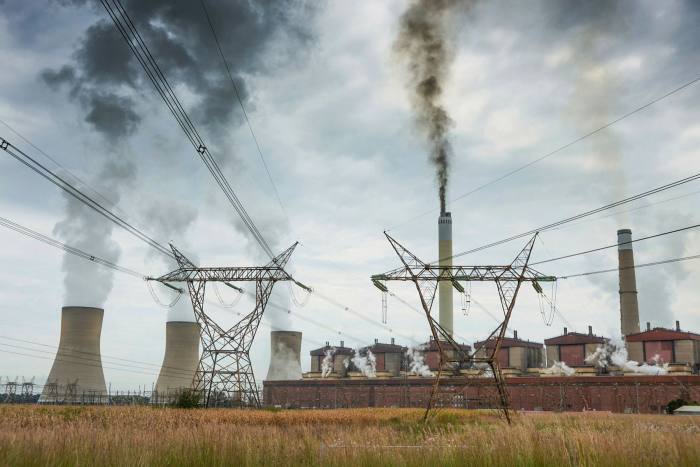Every time South Africa’s struggling state-owned Eskom power monopoly announces rolling blackouts, it marks a bittersweet moment for Herman Maritz, developer of an app that helps users to plan for electricity outages.
The power cuts in Africa’s most industrialised economy, which have persisted for more than a decade and are known locally as load-shedding, have in recent weeks lasted up to 12 hours a day, piling on misery for businesses that have been coping with a years-long collapse at the state utility’s ageing coal plants.
But they also drove record numbers of people to EskomSePush, the app — whose name plays on an Afrikaans swear word — which was co-founded by Maritz and his friend Dan Wells seven years ago.
“I wish I didn’t have to build these features for load-shedding,” said Maritz, a tech engineer who switched to working on the app full-time this year. “I hope that load-shedding could just be gone a month from now, and the functions will not be needed.”
South Africa is contending with the legacy of years of failure to invest in new power supply, which has forced Eskom to keep decades-old plants running without proper maintenance. The ailing state utility has been left with as little as 26,000 megawatts of capacity to meet national demand that peaks at 32,000MW in winter — forcing it to cut off up to 6,000MW from the grid at a time.
Up to 2.4mn users a day logged on to EskomSePush this month as wildcat strikes by Eskom workers seeking higher wages exacerbated the collapse and has made 2022 the worst year yet for outages, with just under half of it remaining.

The deepening problems have finally forced president Cyril Ramaphosa to act. Last week he announced a sweeping plan to enlist the private sector “to urgently add much, much more capacity to the grid”.
The requirement for power generators to hold a licence, which previously applied to independent projects bigger than 100MW, will be swept away, allowing mines and other businesses to install their own generating capacity of any size. Under the proposals, the state will also double its procurement of renewable energy this year to more than 5,000MW.
But, despite Maritz’s hopes, and concerns in the ruling African National Congress that the energy crisis will cost the party its post-apartheid grip on national government in 2024’s elections, private-sector projects are unlikely to start relieving the burden on Eskom for some time.
The measures are “a good plan, especially the removal of the licensing threshold. However, it may take a few years before independent producers can meaningfully contribute to the grid,” said independent economist Thabi Leoka. “Building the capacity will take some time, but it’s better than not doing anything as most companies are struggling.”
Ramaphosa faces challenges posed by vested interests. Among Eskom’s problems, he blamed “deliberate sabotage by well-organised criminal syndicates that are destroying the utility and damaging our economy”, such as the rampant theft of spare power-plant parts.
He also faces torpor in his party. Gwede Mantashe, the energy minister, has in recent months dismissed complaints that power procurement was progressing too slowly. “The same people tasked with implementing the new plan are the same ministers who could have implemented these plans all along,” Leoka said.
The ANC heartlands cover coal-mining regions that supply Eskom. Party factions favour state direction of these resources rather than independent renewables. Eskom delayed signing contracts with renewable providers in 2016 which had a knock-on effect on holding more rounds of procurement.
“There is a history . . . of obstructing renewables because you want to protect the gravy train around incumbent resources,” said Grové Steyn, managing director of Meridian Economics, a consultancy. “The problem is not red tape. It is political resistance.”
At the end of 2020, South Africa’s renewable capacity was 6,700MW — or about 16 per cent of total capacity.

Had South Africa procured an extra 5,000MW of solar and wind supply between 2016 and 2021, almost all of last year’s blackouts could have been prevented, according to estimates by Meridian that assume renewables would have better supported Eskom’s back-up power generation than coal.
“We are primarily energy-short, not capacity-short . . . capacity is just a potential to generate, energy is what you can keep generating,” Steyn said. He added that the Eskom strike “disrupted a system that is already on thin ice”.
In order to power back-up plants Eskom had already burnt about 270mn litres of diesel from January to May this year, before the worst rolling blackouts, compared to about 450mn litres in the year to the end of March 2021.
The increasingly frequent blackouts of recent weeks have taken their toll on South African businesses of all sizes by sapping diesel supply for generators and draining mobile phone tower batteries.
Despite industry group Business Leadership South Africa hailing Ramaphosa’s plan as a sign that “we are finally moving in the right direction”, many companies are hedging their bets. MTN, Africa’s largest mobile carrier, is adding to a fleet of more than 2,000 generators to keep towers running.
As South Africa waits for new power investments, running diesel generators and hiring security to guard them are deadweight costs for businesses in an already stagnant economy, Leoka said. “This is money that could have gone elsewhere, into investment or employment.”
EskomSePush is selling technology for businesses such as banks to integrate its app into their systems — such as a feature warning remote workers when the next power cuts will take place. A product is also in the works for homeowners aiming to sync rooftop solar and batteries with power cuts as they increasingly go off grid.
Maritz would prefer to work on South Africa’s many other problems. EskomSePush added a new “Ask my street” service to enable South Africans to report and fix local water and non-Eskom power outages more effectively.
“A little part of me is thinking . . . let’s help South Africans help each other as well,” Maritz said. “I hope that we can use load-shedding as a launch pad to build something bigger.”
Climate Capital

Where climate change meets business, markets and politics. Explore the FT’s coverage here.
Are you curious about the FT’s environmental sustainability commitments? Find out more about our science-based targets here










